|
Glenn
Harper, editor of Sculpture since April 1, 1996, was formerly
editor of Art Papers magazine, a regionally based, nationally distributed
contemporary arts magazine. Harper has written for Art Papers, Aperture,
Artforum, Public Art Review, On View, Afterimage, and many other
publications. He is the editor of Interventions and Provocations:
Conversations on Art, Culture, and Resistance, a collection of interviews
with contemporary artists published by the State University of New
York Press in 1998.
GH: Your work seems
to start with stone, even though you have most often used it in
conjunction with metal.
John Van Alstine:
Stone is central to my work, although I do most of the hands-on
work with the metal. My first stone works were carved, but it didn't
take long for the idea of smoothing out the stone, trying to make
it into something that it wasn't (the Arp or Brancusi influence)
gave way to artists like Noguchi and other influences such as Japanese
gardens where stone is accepted, even championed for what is. I
grew up in upstate New York and spent a lot of time in New England,
I vividly remember the rough split granite fence posts, sidewalks
and outcroppings of granite. I’m sure this early exposure
has had a impact on my interest in rough-hewn stone. But getting
back to your question, like many sculptors of my generation, particularly
ones that work with steel, I was/am influenced by David Smith, and
a kind of American “take charge” attitude toward the
material. So, yes I start with stone, but ultimately the work is
a confluence of different materials and approaches to them. The
duality of an eastern or oriental acceptance of stone and a 20th
century industrial American “can do” attitude toward
metal is at the core of my work and is, I believe, one of the important
things that distinguishes it.
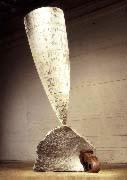 |
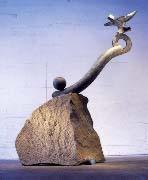 |
Chalice, 1995.
Aluminum, granite,
and steel
128 x 50 x 36 in. |
Juggler, 1994.
Green granite and bronze,
98 x 80 x 32 in. |
GH: What led you
to assemblage as a method?
JVA: Very early I
realized that I wanted to work larger, so I started using multiple
stones, and then introduced wood elements. I began using stone as
an additive element rather than carve it in the traditional subtractive
way. Some of pieces incorporated found curbstones that were pinned
together resulting in a gestural, 3-d calligraphic statement (another
oriental influence). The drilling channels in the rough stone gave
the work a "quarry graphic” adding a visual cadence and
reveled a history of how the material was extracted from the ground.
Also, because of their cylindrical nature, the channels suggested
a logical way to connected the stone via solid round bar which,
in the early sculpture appeared as sort of large staples.
Soon however I realized that I wasn't really using the full expressive
potential of the materials. If the work was about assemblage and
the nature of the materials, I felt I needed to create a situation
where each material revealed essential intrinsic characteristics.
In these early works the steel could have just as well been binder's
twine or rope for example, it wasn't essential that it be steel.
So, I eliminated the wood and started taking greater advantage of
the structural capabilities of the materials, creating systems of
interlocking steel bar to control and to hold the stone. Pieces
like Boundary 1976, developed where the granite is literally "bound"
by the steel in a way that the four stones rest on their edges with
an opening underneath. To assemble the work the stones are propped
up and the formed steel rod is wrapped around them, then the blocks
are kicked out and the whole piece settles into a bound position.
Because of the tremendous gravitational and real internal energy
involved, theses works were virtually “loaded" or "set"
much like a mousetrap. In fact, one thing that was exciting about
this series was I felt I was creating very “realistic”
sculpture precisely because of the real energy involved; much more
then say traditional sculpture or painting that rely on illusion.
Other pieces such as Crimp 1976 and Torque I 1976, developed where
the weight of the stone applied the energy to "crimp"
or 'torque" the bars together and actually provide the glue
that held the works together. Each element and its positioning was
a necessary one. The slightest change in the structure could be
enough for its collapse. I wanted the works to have a sense of arrested
motion and be kind of a static energy event. A large part of the
content of this series focuses on the idea of assemblage and I needed
the work to speak directly to that; it is assemblage about assemblage,
sculpture about sculpture.
GH: The relation of
your work to landscape seems to have a lot to do with the tension
of human effort in the landscape, rather than a "pure"
landscape, it's not Frederick Church, it's the farmer or laborer
at work in the landscape.
JVA: I am not interested
in landscape as an illusion. Because I'm a hands-on person for most
of my works, I relate to things at a scale which can be humanly
manipulated. I'm not personally interested in doing earthworks like
Micheal Heizer, with a giant bulldozer, but I do respond to the
idea of the farmer taking a plow cutting lines in the field. I relate
to what is done in or to the field, but I am even more interested
in the tools/ implements used and their functional and conception
relationship to the landscape.
GH: How did the landscape
in the West affect your materials and your ideas?
JVA: In the fall of
1976 I moved to Laramie to accept a teaching position at the University
of Wyoming. Up until then I had lived in the East were the landscape
is generally obscured by vegetation. The western landscape was stripped
bare, revealing the geology and conveying vast amounts of information
about its formation and history. Considering stone was my primary
material, all of this had a profound impact. There was a different
and empowering sense of scale, I was taken by the towering buttes
and unbelievable natural arches which ultimately let to a Totem
and Arch series that I still work on to this day. I was struck by
the overwhelming amount of sedimentary stone, created by millions
of years of layering. Sparked by Jackie Ferrara’s 1970’s
stacked plywood pieces and the way they were informed by the layers
in that material, I started building works that incorporated stacked
Colorado flagstone to echo or reiterate the nature of the material
and how it was came into existence. Coupling the "interlocking”
steel bar vocabulary that I had developed with massive stacked columns,
created structural systems that were not held together by welds,
but rather by the controlled and channeled gravitational energy
of the tremendous stone piles. In theory the higher the stack, the
greater the energy and the stronger the "glue" which held
them together. Some works in the series were left open on the top
suggesting the pile could continue indefinitely, recalling and paying
homage to Brancusi's Endless Column. They were titled Stone Pile
I, Stone Pile II and so on and like earlier works Crimp and Torque,
the title was both a noun and a verb indicating that the sculpture
was as much an action as a object. The more I worked on this series
the more I realized how much a fundamental human activity stacking
is, it was a common, universal form of “sculpture”.
We stack to store, to move, to count, to take inventory, to build
etc. I began to notice all kinds and ways, different shapes and
forms, with lumber, firewood, stone, hay, many types of architecture
etc., all of which further informed and influence new works in the
series.
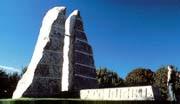 |
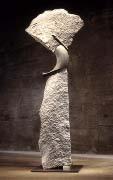 |
Solstice Calendar, 1986
Granite and stainless steel,
20 x 29 x 20 ft. |
Delta, 1991.
Bronze and granite,
110 x 43 x 24 in. |
GH: Tripod with Umbilical
1982, is a work that marked a shift, a breakthrough indicated by
that line trailing off into the air.
JVA: I had moved to
back East to Washington, DC late in 1980 and for a while I continued
to work with sedimentary stones. But soon the influences of the
urban landscape and the feeling that I had exhausted the very tight
formulated interlocking no frills work, led me to consider other
options. The Tripod piece was almost like my flag going up to say,
"I've done this, and I'm beginning to break away". The
"umbilical" or squiggly steel bar was a sort of lifeline
back to where I had been and forward to something else. The next
important piece In the Clear 1982, combined this continuing need
to break away with a timely discovery of a supply of crushed I-beams,
pipes and tubes, as part of a subway construction yard just outside
the city. The piece incorporates a physical suggestion of vegetation
and in one way it is a landscape reference "in a clearing",
but at the same time it's about "breaking clear" from
that self-imposed restriction of only making work that was structurally
driven.
GH: The found objects
in the more recent works are ultimately as much landscape, urban
landscape, as the pieces that reflect the Western landscape.
JVA: In order to be
closer to New York I moved from DC to Jersey City in 1983. The industrial
and marine salvage landscapes there have had a major impact on my
work both as a source of found objects such as anchors, chain, buoys,
cleats; and as an place with unique and compelling characteristics.
Works like Link I and II, I feel are a sentinel pieces, and speak
directly to one of the core aspects of my work - the marriage of
very different materials - creating a meaningful amalgam from natural
and human made things. The large piece of chain at the center of
these works literally linking the elements is called a "pelican
clip," because of its shape and function of clipping large
pieces of chain together. The fact it is a connector, kind of "super
link", and because of its position in the work, intensifies
and underscores the central idea of union.
The calming characteristic of marine salvage yards, basically in
the center of busy urban environments has always surprised and attracted
me. Perhaps because it’s a transition zone from the intensity
of the city to the serenity of the sea, in any case, it has inspired
many works. Tether (Boys' Toys) 1996, for example, uses a 1500 pound
anchor to hold aloft a large piece of animated welded chain and
a wafting torpedo form. It generates a passive, almost weightless
feeling of being viewed from underwater. When I was working on it
I was reminded of the magic I felt as a kid when I first saw farmers’
mailboxes along a county road floating a top of welded chain. The
fact that the piece simultaneously conveys a sense of "folksy"
and “marine urban” attracted me. As the piece developed
further it began to suggest the model airplanes I built as a kid,
thus implying toys. The floating cigar/ missile/ penis form seemed
to demand that it reference “boys’ toys” which
added layers of symbolism and association. When completed I felt
it pitted playful innocence against sinister, rural against urban,
which created a very interesting tension.
I have several works that use large ocean buoys found in these yards,
in fact one is titled Buoy. It has occurred to me that the act of
making art is like dropping buoys as you bob along in your "stream"
of creativity, leaving floating reminders of where you've been.
Buoy 1995, attempts to formalize and convey this idea.
GH: So the found objects
link the stone actually drawn from the landscape with urban, rural,
and industrial environments. You mentioned tools, and a lot of the
found objects seem to have to do with working, with effort or fabrication.
JVA: As a sculptor
I've always been interested in tools, implements, and instruments.
I see them as extensions of the artists’ hand, important allies.
I am also drawn to their raw, efficient beauty of form dictated
by function. I am certainly not unique in using tools, David Smith,
Jim Dine, Picasso and many others have staked out some very impressive
territory. But I feel I have something to add to the mix based on
my unique experiences and perspective.
Growing up in New England for example, it is hard not to be impressed
by its beautiful stonewalls both in terms of the way they knit together
the landscape (they are the bones) and by the sheer pre-industrial
effort it took to form them. In Sledge 1992, I wanted to pay homage
to that effort and beauty by creating a piece based on the "stone
boats" or "sledges" that farmers used to use to drag
stones from their field to the edges, to build these walls. In the
piece the bed of the sled and its cargo were designed to be one
in the same, the single large flat piece of granite acts simultaneously
as both. There is something important about this union. Perhaps
it’s because it presents a “oneness” with the
material, tool, intent and final product.
Many of my works incorporate anvils either real or cast. Anvils
have the shape suggestive of a of a boat or vessel which implies
journey which interests me. But further, as a metal worker, it is
the place where I physically and conceptually forge things together,
there is an art spirit that comes off the anvil. It‘s almost
like an altar. I've titled many of these pieces Ara, which is Latin
for altar. Also, to me is the quintessential heavy object and to
get it up in the air creates a wonderful sense of tension.
I use references to tillers, both in the sense of the agricultural
implement and tiller as a navigational devise. The idea of an instrument
that aids one in carrying out decisions, to chart a course, is significant.
It can be seen as a metaphor for the very thing that distinguishes
us from other beings on the planet and provides a wonderful creative
vehicle. The scale or balance beam is a tool/ideal that provides
another vehicle, in part because much of my work is concerned with
physical balance. One piece in this series is Astraea's Beam 1991,
Astraea being the goddess of justice. Its un-natural positioning
addresses the question the equality in our contemporary judicial
system.
GH: There are other
seagoing references, especially vessels.
JVA: The ship or vessel
is a common and perhaps universal metaphor for passage used thought
out art and literature. Many of the found objects that I was attracted
to suggested boat forms and in an attempt to broaden my work, I
started to incorporate them. Actually the vessels in my work started
out first as containers influenced by my background as a potter.
I put myself through graduate school working as a production potter
and playing off the idea of a functional vessel is in my vocabulary.
The Chalice series, for example, starts with the suggestion of function,
but because of their scale (6-13 feet), the unusual combination
of materials and unnerving positioning of elements, they move beyond
function and transform all the elements including the open-ended
aluminum aeronautical fuselage into something akin to spirited “cups
of life”.
 |
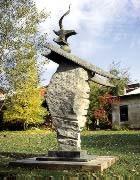 |
 |
Tether (Boys Toys), 1995
Aluminum, granite,
and, steel,
16 x 14 x 10 ft |
Boys Toys II, 1996
Granite and bronze,
117 x 60 x 27 in. |
Buoy, 1995
Granite and bronze,
11 x 10 x 5 ft. |
GH: In this series
did you polish the aluminum to get the color?
JVA: Sort of. I took
a belt sander and worked through the applied paint reveling different
layers of color and in some places sanded down to the aluminum.
In a way, it's a lot like my drawings, where I'll add color, build
up layers of pastel, charcoal, and then go back with an eraser,
digging through to reveal some of what's underneath. For me drawing
is a release. It is similar to working with clay - putting material
on – taking it off, until an interesting balance is reached.
Like clay, the drawings respond to the touch, stone or steel demand
machine tools to be manipulated. I do drawings all the time, the
spontaneity and easy manipulation of the medium is a great counterpoint
to the often long, deliberate task of building a sculpture. Sometimes
the drawings are fantasy pieces used to develop ideas that may or
may not be impossible to translate to 3-d. Others are of finished
work, kind of a 2-d and often very colorful interpretation.
9A. Your color photographs
seem to deal directly with landscape, do they relate to your sculpture?
JVA: The photographic
Easel Landscape Series 1978-80, was a direct spin off from the sculpture.
In fact the 6’ steel easel central in all the photographs
was originally made for an indoor piece where I was exploring the
idea of framing. For fun I set it up outside and was amazed what
happened, there was an immediate connection to Magritte and his
paintings of the easel against a wall suggesting a window, the ones
where there is a painting of a painting; illusion of an illusion.
I felt there was potential for something in all of this and I began
taking it with me when I traveled. It actually became a great excuse
to get out into that wonderful landscape and feel like I was working!
I viewed the photographs as documents of sculptural installations
– the placement of the steel easel in specific landscapes.
They were about sentiment, perception, the convention of the frame
our inability to contain and compartmentalization that incredibly
expansive landscape. There were some of haystacks – Monet
Easel Landscapes; there were Abstract Easel Landscapes. I photographed
in places like the famous artists’ point in Yellowstone Park
conjuring the ghosts of Bierstadt and Moran. It was a very fun project
inspired and propelled by that fantastic landscape. Once I move
East, the urge to continue evaporated.
GH: How do you plan
the pieces? Do you select the materials first or match the materials
to an idea?
JVA: I seldom work
from a predetermined plan or drawing. I have a big reservoir of
found objects; stone, steel and other non-metallic objects. When
I travel I try to collect interesting things that I think someday,
somehow might inspire a piece. In the studio I do a lot of experimenting,
like an alchemist putting stuff together until something happens.
Sometimes it works and sometimes it doesn't, you keep at it until
you feel like you've got something. I like to use a fishing analogy;
you work hard to get a “keeper”, sometimes you have
to “throw it back”. The fun part is bringing desperate
elements together and never quite knowing where it's going to lead.
Usually the piece reveals itself as it's developing, in terms of
what the title might be or ultimately what it is.
GH: There is a figural
aspect to your work that is (except for the large public pieces)
it's at your scale, you are in the middle of it putting it together.
But there are also more explicit references to the figure.
JVA: For a long time
I really didn't want to acknowledge the figure, but I came to the
point where it was an conscious aspect of the work. Reconsidering
Sisyphus 1992, for example, is in a way a self portrait of my own
creative struggle. One of the ways to interpret the formal arrangement
of the stone and steel in this piece is as a figure frozen in the
act of prying or pushing a stone as in the myth of Sisyphus. In
a way that's what I do! I am out there literally pushing stone around
aiming for this very elusive place, and once there, I start over
again, with no real “end”. The title arises from Camus’
Myth of Sisyphus, where he “reconsiders” Sisyphus’
labors. For the artist the creative experience is not a goal, one
never just reaches the “top” and says “I’m
done”, but rather spins in a continual regenerative cycle
where the value and reward emerge from the process. It seemed like
a perfect analogy.
Some more recent pieces refer to movement of the figure, particularly
the Juggler and Pique `a Terre series. Pique `a terre is a term
from classical French ballet for a pose where one toe touches the
ground, the other foot is firmly planted, with a sweeping arm gesture.
Once you are aware of the title and you see the piece, the connection
is clear. I am in a sense choreographing these works, getting a
heavy weight off the ground and making it dance. Taking what is
often seen as a negative, the fact that stone is damn heavy and
a big hassle to move around, and turning it into a positive. It
is this transition that helps give theses pieces their magic.
GH: Do you select
stones rather than have them cut?
JVA: I have a flatbed
truck with a crane, and I go to the quarries or stone yards and
pick the pieces, bring them back and have them around in a kind
of “reservoir” to select from. Generally I look for
stones that have a fresh, clean, geometric character, they seem
to lend themselves best for combining with other materials. Granite
works well for my current work because it is very durable and can
stand up to the “abuse” I tend to put it through. I
also like its subtle, inert character. It does not call too much
attention to itself, is not a overly “pretty”. I also
am attracted to the subtle sparkle of the mica that is embedded
in it. Split granite elicits a similar ephemeral sparkle seen in
freshly fallen or drifted snow, yet it is such an obdurate material.
I like the contrast.
GH: For the large
public pieces, is there also a found-object quality in the stone.
Are you actually cutting a piece to match a maquette?
JVA: Landing large
commissions can be really tough for me. I present a scale model,
but there is no way that I want to go out and try to chip a large
stone into that exact shape. It would never have a sense of spontaneity
or freshness that I feel my work demands. So I’m always making
qualifications, saying "This is the spirit of the work, and
we will find a stone that will convey those same movements and characteristics,
but it's not going to be exactly the same – hopefully it will
be better!" The trick is to get the client or committee to
trust you so they are comfortable with this way of working, sometimes
that‘s hard.
GH: Your public works
have their own distinct imagery, they don't just use the smaller
works as a template. How did that develop?
JVA: I had a chance
to spend time in England and visited many standing stone sites.
It got me thinking much larger, thinking about placing stones in
a way that would track larger landscape forms or the movement of
the earth and ultimately create work with a more meaningful connection
to their site or setting. Trough 1982, my first large scale public
piece in Billings Montana, consists of two large slabs of granite
held in perpetual suspension by two interlocking linear steel elements.
In addition to being the climax of my early “tension”
pieces in terms of scale and raw power, the physically charged negative
space created between these very large “arrested” stones
was designed to echoed the main geological formation in the area,
an impressive trough cut through the high plains by the Yellowstone
River. This connection helps “seat” the work in its
locale and imbue it with even greater power.
Other public art pieces were in part influenced by sites out West,
like the Anasazi sun dagger, as well as Meso-American pyramids and
observatories. Solstice Calendar 1986, built for Austin College
in Sherman, Texas for instance, has two large, 22’ high columns
of stone connected near the top with a 4” diameter stainless
steel rod. The work is aligned north/south so that on the summer
solstice, light from the noon sun which is then at its highest,
passes light through the columns and creates a shadow which aligns
with the solstice bar on a third low horizontal stone element. Each
day that follows the noon sun is a bit lower, creating a shadow
a little further down the horizontal stone. It reaches the equinox
marker on or around March 20, continuing until it arrives at the
winter solstice bar where it reverses course and returns to complete
the cycle. The sense of time, space, place and the cyclical nature
of our existence evoked by the work transcends its physicality.
It is successful both because it directly addresses the ideas of
site-specific and placement and also provides multiple points of
access which allows a ”public art audience” to make
a meaningful connection.
GH: In a catalogue
for a 1998 exhibition at the Plattsburgh State University Art Museum,
you used the word "impure" to describe your materials,
in particular the found objects.
JVA: Found objects
are never “pure” in the sense that they are imbued or
tainted with layers of information, history, associations, symbolism
as a result of our individual experience with them in the “real”
world. Combining them together and with natural objects, like stones,
can result in a combustible mix that one can mine information and
elicit emotion, compassion, and reaction.
 |
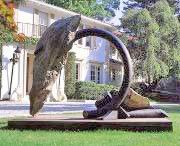 |
Tripod with Umbilical, 1982.
Yellow granite and steel,
72 x 80 x 92. |
Pique Terre VII, 1999.
Granite and painted steel,
6 x 8 x 4 ft. |
GH: More recently,
you've included another category of found objects, animal horns
and other organic forms. What led you to use those natural forms,?
JVA: The introduction
of organic, animal horns and other nautilus-like forms, is really
a spin-off from the arc that I've used a lot, a pure geometric shape
that is an ideal link between disparate materials. I've been looking
for ways to expand that idea. Currently I live in the Adirondack
Mountains where hunting is a big part of the history and culture.
You see a lot of mounted trophy heads – taxidermy is big -
in a way it is a local form of sculpture. I find many of the horns
very exciting from a purely formal aspect. Plus, like in Almathea
II 1998 and Hornhammer (Rouge) 1998, their use adds all kinds of
interesting symbolism and associations that can be woven into the
intent and content of the work. Once they are cast in bronze, you
can weld them and use them as you would any metal element. I’m
not sure where it all will lead, but it seems interesting at the
moment.
GH: Your use of color
has changed from the stone and steel works, to pieces with applied
color, to the combination of bronze and stone.
JVA: The stone in
the early stacked pieces is Colorado flagstone, it's kind of neutral
“pukey” pink in color. You'd stack it on the truck and
it would scrape and take its own marks of use creating an interesting
patina and revealing a sense its history. Because the stones were
all flat and rectilinear, the marks began to appear like writing
on a tablet, in a way describing what they were and where they had
been. That weird color was wonderful because I wanted the viewer
to focus on the stone’s volume, its weight, its history, its
geological layering, not how pretty it was. I have always been put
off by stone that seem too “pretty” or polished and
looks like plastic. They attract attention for the wrong reason
and seem too sweet. They hurt my “aesthetic” teeth.
In some later pieces I added color to the stone, thinning enamel
and letting it soak in. This was influenced partly by living in
the West where I came across stones that seemed unreal because of
their crazy shades of gold or yellow. By slightly tinting the stones
in the sculpture, I was able to tap into a similar sense of mystery,
getting to the point where most people didn't know if the color
was real or altered. This created an interesting tension.
When I started to use bronze one of the things I discovered was
the appealing range of color available though the patina process.
They were very subtle and natural, it struck a cord with my “ceramic
glaze” sensibility. As you can see I tend to cycle in and
out of different phases with color.
GH: How does that
sense of color relate to the more recent pieces with additive color?
JVA: The addition
of color on pieces like Drastic Measures 1984-7 or Luna 1985, and
others done around the same time, came as a spin-off of my work
with pastels drawings. At that time I was using mostly gray granite
and steel, which can be very monochromatic, and I got to a point
where I felt I needed more color excitement. This use of color differed
from the very early painted works that were more like stoneware
glazes, muted very earthy very low-key colors, influenced by my
work as a potter.
GH: In some of the
more recent pieces, like Column II 1999, there is a lot of color.
JVA: Yes, I guess
that's my recent reaction to late winter in the Adirondacks, it
seems mostly gray up there then. I started experimenting with color
again, with very flat enamels, first applying different and distinct
color on each of the geometric elements of a work, and staining
the stone. By the end of that series (there were five columns) I
began blending the colors, rubbing through them with solvents to
reveal some of the layers underneath. To mute things a bit I added
dark sprays, working the surface like my drawings. I guess working
through the cycle I ended up near, but not quite where I started.
This happens a lot with my work, it’s one way it grows. I
push out in a new direction, reaching a point of being uncomfortable
and then cycle back, hopefully not to the exact spot, stay there
for a while, then launch out again.
 |
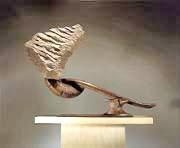 |
Offering (Running Column)
1999. Bronze and granite,
71 x 28 x 20 in. diameter |
Hornhammer-Rouge, 1998
Bronze and granite,
28 x 38 x 11 in. |
GH: When did you start
working in bronze?
JVA: Somewhere around
1988-89. There were a couple of reasons: maintenance of outdoor
works, and I wanted to re-use some of the particularly interesting
found objects in several different pieces. I work with a foundry
in Brooklyn that does sand casting, and that is great for me, because
in 99% of my pieces are unique. The fact that I am not usually interested
in editions makes sand casting efficient and reasonably economical.
I take parts that need cast to the foundry and retrieve their bronze
counterparts just the way they come out of the sand. I like the
rips, tears and textures that occur during the casting process.
I approach them like a new found objects, accepting and incorporating
their new information into the piece. Once back in my studio, the
bronze is fit with the stone and I do whatever welding or pinning
that is needed, then the patina is applied. Casting both expands
what I can do with the objects and introduces fresh important new
information to the mix.
GH: Your work has
a suggestive rather than a linear relationship with the mythologies
and the histories and landscapes that you refer to. Do you think
that comes from the additive way that you work?
JVA: I think so, as
I'm putting objects together I try to be very mindful as to their
individual associations, their past histories and ultimately what
they will communicate when combined. Sometimes when working a mythological
reference or interesting notion about the landscape will suggest
itself which provides a vehicle for comment or communication. I
guess the trick is to be ready or open to those suggestion when
they arise. Like most artists, I'm looking for common truths or
conditions that not only speak to me but make sense and connect
to a broader audience.
GH: All your work,
not just the large public art, has an epic quality - suggesting
the sweep of human history, a larger language or scope. Is that
an outgrowth of a conscious choice to look in the long view, the
large scale?
JVA: Yes, in my mind
significant sculpture or art strives to reveal universals, rather
than being navel-oriented. I'm interested in making statements or
raising questions that generate discussions on broad, universal
topics, uncovering truths that resonate and echo. I see my work,
when it is at its best, as a lens that can help provide focus to
a “big picture”.
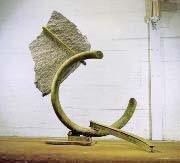 |
Tiller, 1994
Granite and bronze,
96 x 93 x 64" |
|
 |
